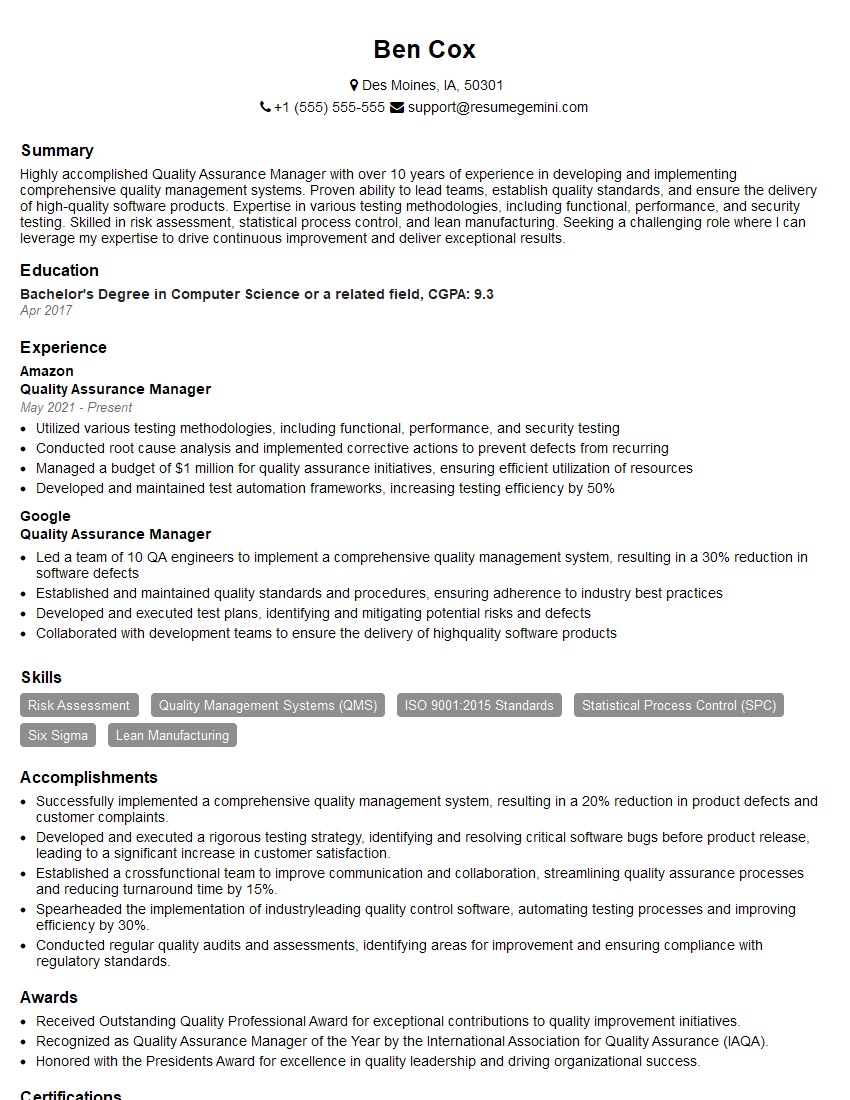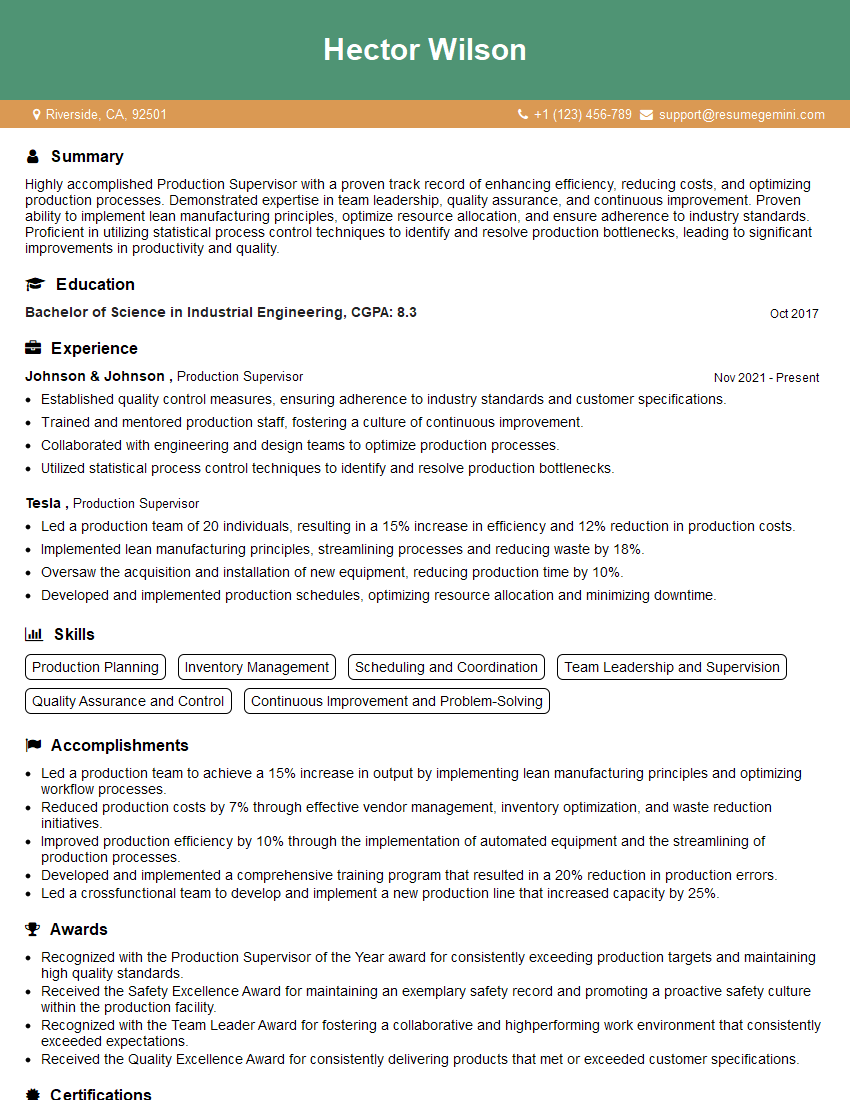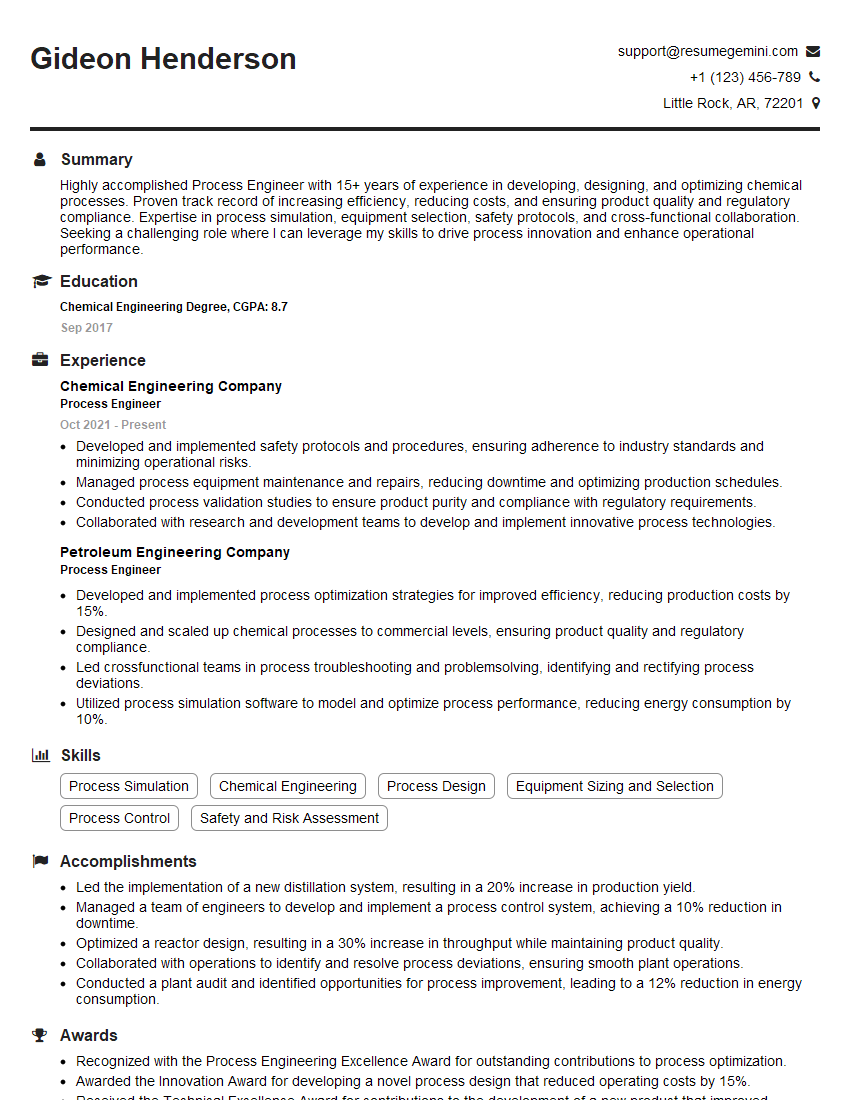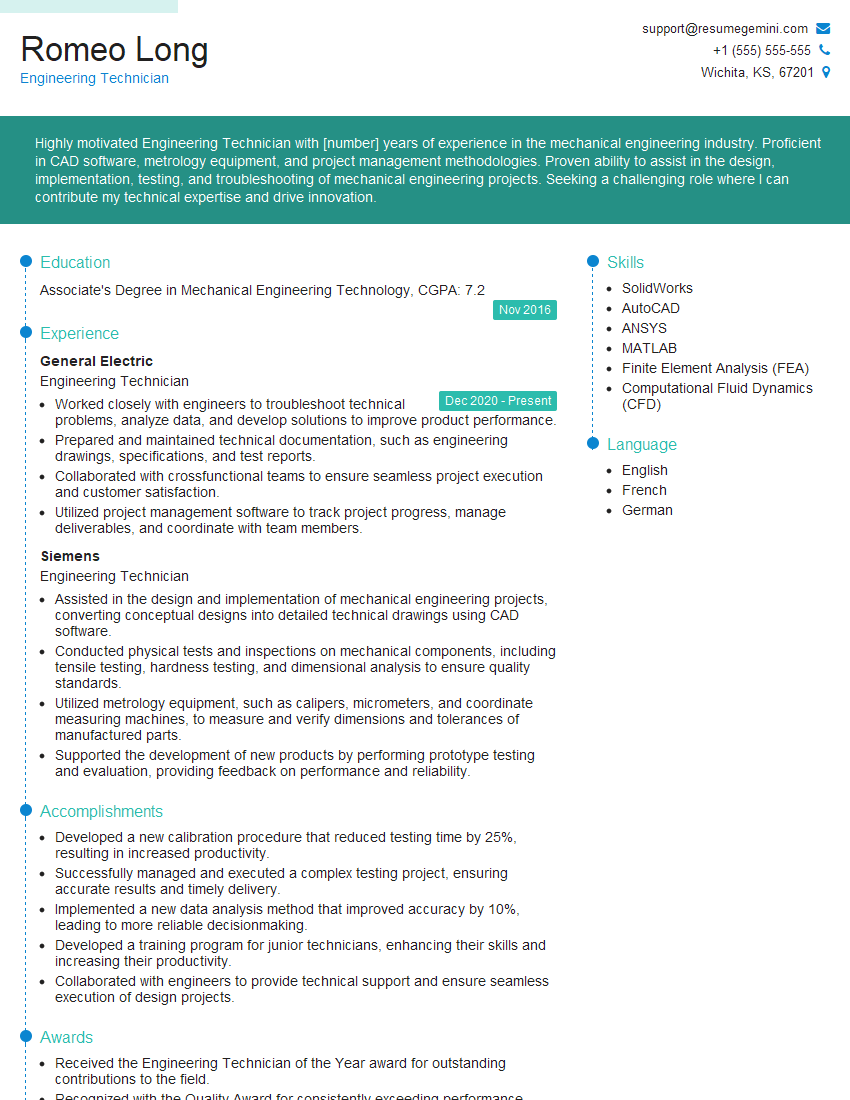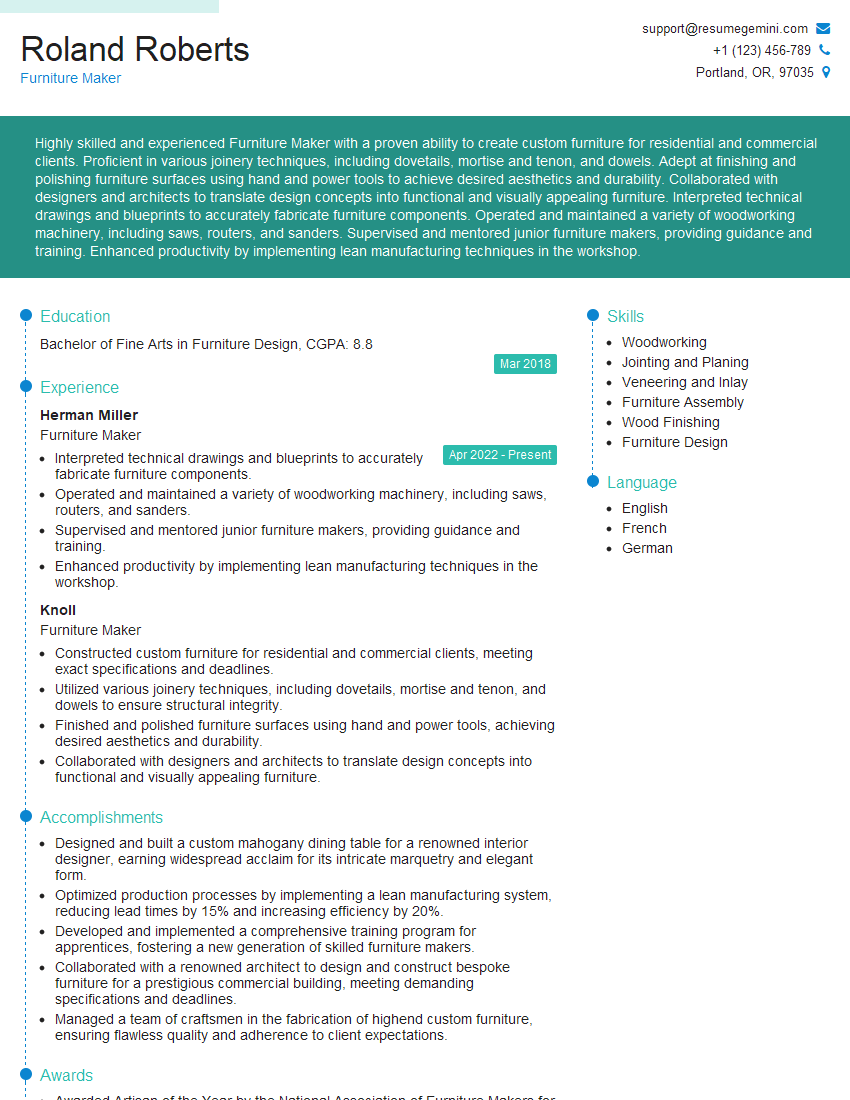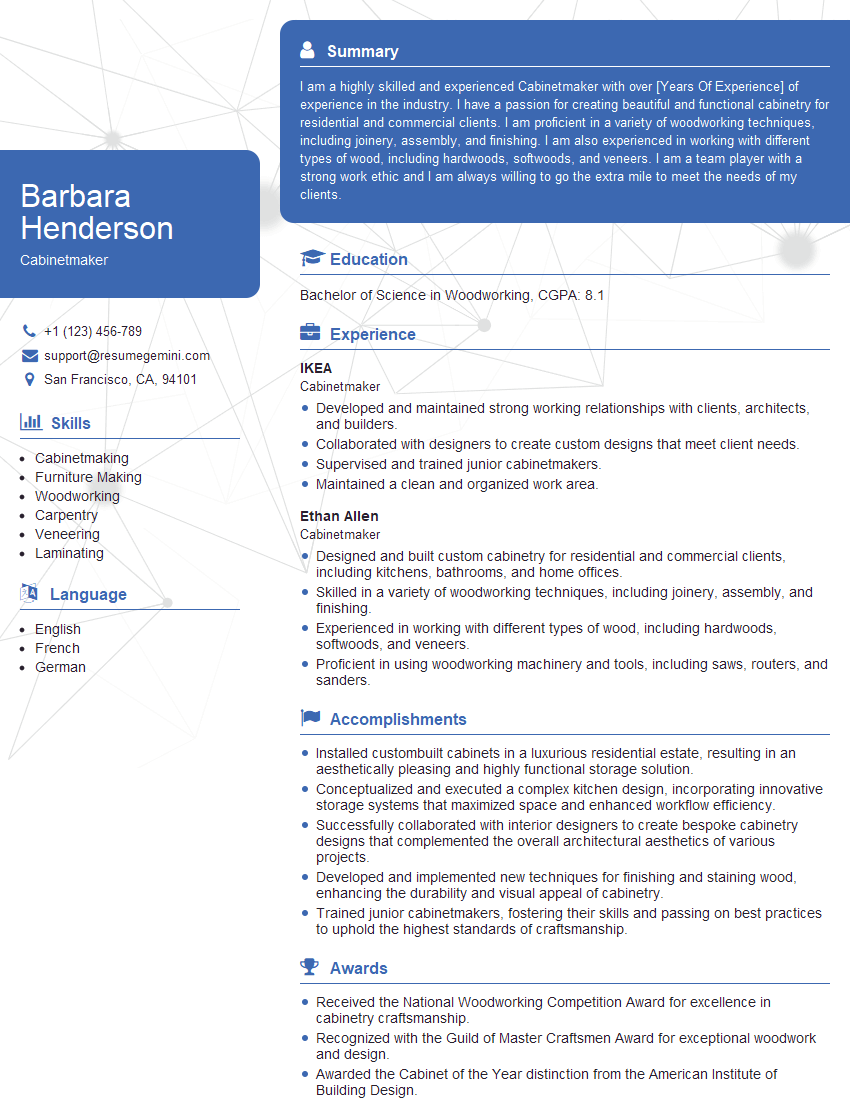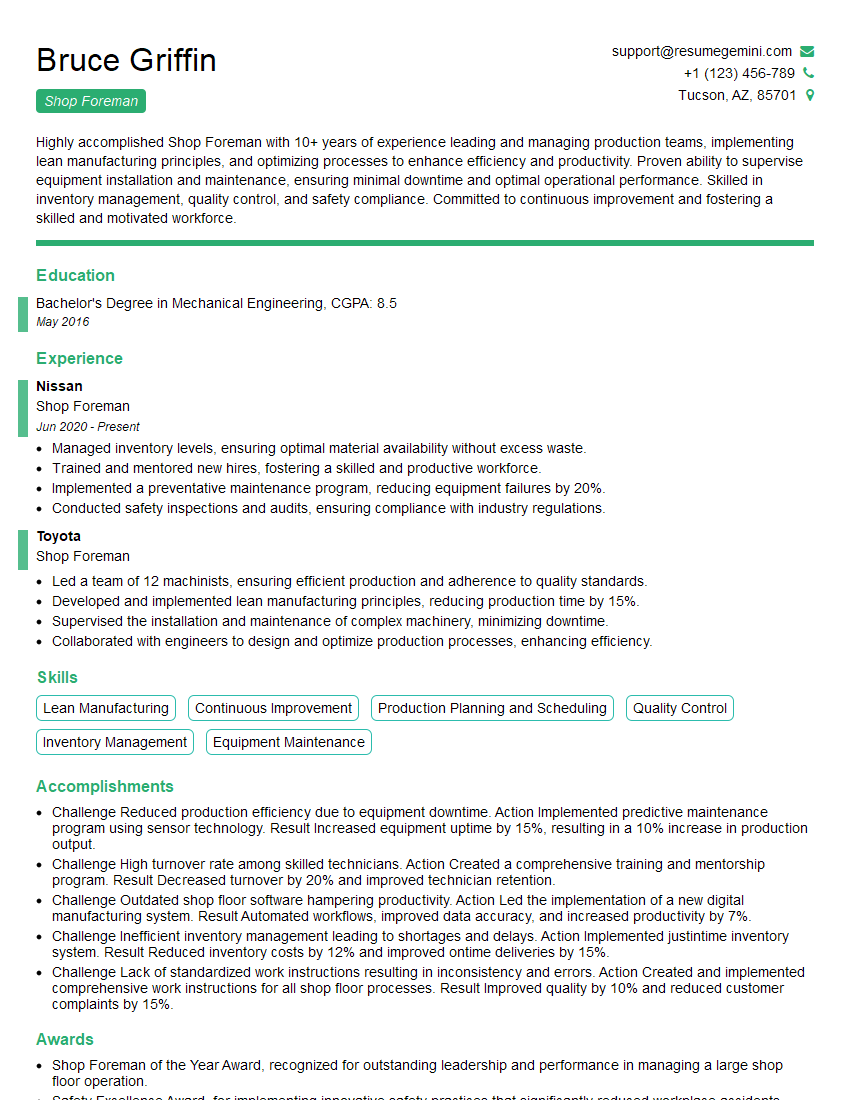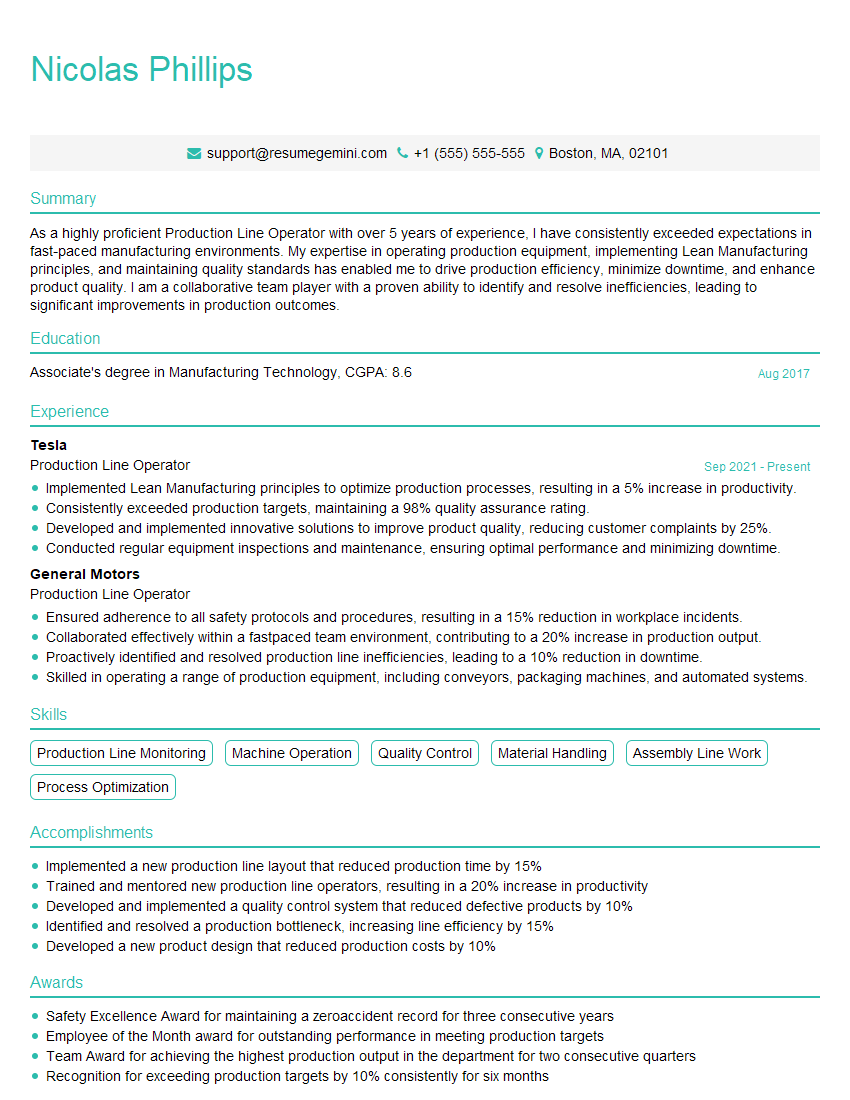Interviews are opportunities to demonstrate your expertise, and this guide is here to help you shine. Explore the essential Edge Joint Cutting interview questions that employers frequently ask, paired with strategies for crafting responses that set you apart from the competition.
Questions Asked in Edge Joint Cutting Interview
Q 1. Explain the different types of edge joint cuts.
Edge joint cuts are crucial in woodworking and joinery, enabling the creation of strong and aesthetically pleasing connections between two pieces of material. Different types cater to specific needs and design aesthetics. The most common types include:
- Butt Joint: A simple joint where the ends of two pieces meet squarely. It’s the most basic but requires careful preparation for strength.
- Miter Joint: Two pieces are cut at an angle, usually 45 degrees, to create a visually appealing angled connection. Requires precision cutting for a perfect fit.
- Lap Joint: One piece overlaps the other, creating a strong joint often used for frames and boxes. Variations exist, including half-lap, through-lap, and finger joints.
- Dado Joint: A groove (dado) is cut into one piece to receive the edge of another. Very strong and often used in shelving and drawers.
- Rabbet Joint: A rectangular groove is cut along the edge of one piece, allowing another to fit into it. Often used for frame construction and cabinet making.
The choice of joint depends on factors like the material, the required strength, and the desired aesthetic.
Q 2. Describe the process of creating a butt joint.
Creating a strong butt joint requires meticulous attention to detail. The process involves:
- Marking and Measuring: Accurately mark the cut lines on both pieces of wood, ensuring the ends are perfectly square and aligned. Use a square and pencil for precision.
- Cutting: Use a sharp saw – a handsaw, miter saw, or table saw, depending on the material thickness and precision needed. Make clean cuts, avoiding tear-out.
- Surface Preparation: Ensure the cut ends are perfectly flat and smooth. Use a hand plane or sandpaper to remove any imperfections.
- Assembly: Apply wood glue to both cut ends and clamp the pieces tightly together, ensuring proper alignment. Let the glue dry completely.
- Finishing (Optional): Once the glue is dry, remove the clamps. You can add further reinforcement with screws or dowels for added strength in high-stress applications.
Remember, a well-prepared butt joint will be significantly stronger than a poorly cut one. The emphasis on precise measurement and clean cuts is paramount.
Q 3. How do you ensure accuracy when cutting edge joints?
Accuracy in edge joint cutting is crucial for a strong and aesthetically pleasing result. Here’s how to ensure precision:
- Use sharp tools: Dull blades lead to tear-out and inaccurate cuts. Regularly sharpen or replace your saw blades and chisels.
- Precise measuring and marking: Use accurate measuring tools like steel rules and marking gauges. Double-check your measurements before cutting.
- Appropriate cutting techniques: Use jigs and guides for consistent cuts, especially with power tools. Employ proper techniques to avoid mistakes.
- Test cuts: Practice cuts on scrap wood before working on your final pieces to refine your technique and ensure your settings are correct.
- Use clamps appropriately: For glue-ups, use sufficient clamps to ensure tight and even pressure during assembly. This prevents gaps and ensures a proper bond.
- Calibration of tools: Regularly check the calibration of your measuring tools and power tools (e.g., miter saw fence alignment) to ensure accuracy.
Investing time in precise preparation significantly reduces errors and ensures a superior finished product.
Q 4. What are the common issues encountered during edge joint cutting?
Common issues in edge joint cutting stem from improper preparation or tool usage. These include:
- Tear-out: Rough or splintered edges resulting from dull blades or improper cutting techniques.
- Inaccurate cuts: Uneven cuts leading to gaps or misalignment in joints.
- Glue squeeze-out: Excessive glue that can compromise the look of the finished piece.
- Joint weakness: Insufficient glue, improper clamping pressure or poorly prepared surfaces result in a weak joint prone to failure.
- Misalignment: Pieces not properly aligned during assembly leading to a visually unappealing and potentially weak joint.
These issues are often preventable with careful planning, proper tool selection, and attention to detail.
Q 5. How do you troubleshoot a poorly cut edge joint?
Troubleshooting a poorly cut edge joint depends on the specific problem. Here’s a systematic approach:
- Identify the problem: Is it tear-out, misalignment, or weak glue bond? Carefully assess the cause.
- Assess the severity: Is it a minor imperfection correctable with sanding, or does it require more extensive repairs (e.g., recutting)?
- Implement a solution: For minor tear-out, use sandpaper. For misalignment, carefully re-clamp and potentially add additional glue. For a weak glue bond, the joint may need to be disassembled and re-glued.
- Consider alternatives: If the repair is difficult, or the joint severely damaged, consider an alternative joint design to minimize rework.
In some cases, the entire joint may need to be remade. Early detection of issues during the cutting process is key to avoiding extensive rework.
Q 6. What safety measures do you take when operating edge joint cutting equipment?
Safety is paramount when operating edge joint cutting equipment. Crucial safety measures include:
- Personal Protective Equipment (PPE): Always wear safety glasses, hearing protection (especially with power tools), and dust masks (when appropriate).
- Secure workpiece: Properly clamp the material to prevent movement during cutting, preventing kickback and injury.
- Proper tool usage: Follow the manufacturer’s instructions for each tool, understanding its capabilities and limitations.
- Sharp blades: Dull blades increase the risk of kickback and accidents. Keep blades sharp and in good condition.
- Clear work area: Keep your workspace clean and organized to prevent accidents. Remove any obstructions.
- Awareness of surroundings: Be mindful of other people in the area when using power tools.
A safe work environment is essential for preventing injuries. Never compromise on safety procedures.
Q 7. What types of materials are commonly used for edge joint cutting?
Many materials are used for edge joint cutting, each with its own properties and challenges. Common examples include:
- Wood: Various hardwood and softwood species, each requiring specific techniques due to differences in grain and hardness.
- Plastics: Different plastics require different cutting techniques due to their varying properties.
- Metals: Cutting metal requires specialized tools and techniques (e.g., metal cutting saws, milling machines) due to its hardness.
- Laminates: Requires careful cutting techniques to avoid chipping or delamination.
The choice of material significantly impacts the tools and techniques employed. Understanding the material properties is vital for successful edge joint cutting.
Q 8. Explain the importance of proper blade selection for edge joint cutting.
Choosing the right blade is paramount in edge joint cutting. The blade’s type, tooth configuration, and material directly impact the quality of the cut and the overall efficiency of the process. Think of it like choosing the right tool for a specific job – using a dull saw to cut through hardwood is inefficient and could lead to a poor finish. Similarly, using the wrong blade for your material could result in chipping, tearing, or uneven cuts.
- Material: Different materials require different blades. Hardwoods often require carbide-tipped blades for durability, while softer woods might be fine with high-speed steel blades. For melamine or other composite materials, you need blades designed to minimize chipping.
- Tooth Configuration: The number of teeth and their arrangement (e.g., ATB – alternate top bevel, TCG – triple chip grind) influence the cut’s smoothness and aggressiveness. Finer teeth produce smoother cuts, but might be slower, while coarser teeth are faster but can leave a rougher edge.
- Blade Diameter and Kerf: The blade diameter should be appropriate for your machine and the material thickness. The kerf (width of the cut) should be considered to minimize waste and ensure accuracy.
For example, when cutting a delicate edge banding, a fine-tooth blade with a small kerf is essential to avoid damage. Conversely, ripping through thick hardwood panels requires a robust carbide-tipped blade with a wider kerf and fewer teeth to withstand the stress.
Q 9. Describe the process of setting up an edge joint cutting machine.
Setting up an edge joint cutting machine requires precision and attention to detail. Improper setup can lead to inaccurate cuts and potential damage to the machine or the workpiece. The steps involve:
- Blade Installation: Carefully install the correct blade, ensuring it’s securely fastened and aligned correctly. This step is crucial and requires checking the blade’s sharpness and potential for wobble.
- Fence Adjustment: The fence, which guides the workpiece, must be perfectly aligned and parallel to the blade. Inaccurate fence alignment will result in uneven cuts. Double-check this using a precision square.
- Depth of Cut: Adjust the depth of cut to match the thickness of your workpiece and the desired cut depth. This is particularly critical for edge jointing, as too deep a cut can damage the workpiece, whereas too shallow a cut leaves a significant lip.
- Material Support: Ensure adequate support for your workpiece to prevent vibration and deflection during the cutting process. Using push blocks and featherboards is highly recommended, particularly on long pieces.
- Test Cut: Always perform a test cut on a scrap piece of the same material to check the setup and blade performance before cutting your actual workpiece. This allows you to make adjustments as needed to ensure precise results.
Remember, safety should always be a priority. Always follow the manufacturer’s instructions and wear appropriate safety gear, including eye protection and hearing protection.
Q 10. How do you maintain and clean edge joint cutting equipment?
Regular maintenance and cleaning are crucial to ensure the longevity and accuracy of your edge joint cutting equipment. Neglecting maintenance can lead to premature wear, inaccurate cuts, and even accidents.
- Blade Cleaning: After each use, clean the blade with a brush or compressed air to remove sawdust and resin build-up. Regular sharpening is essential to maintain sharpness and prevent uneven cuts. Dull blades are the number one cause of poor cuts and material damage.
- Machine Cleaning: Regularly clean the entire machine, removing sawdust and debris from all moving parts. Pay attention to the areas where sawdust can build up, such as the fence and the blade guard. Use compressed air to blow out debris and a soft brush for delicate areas.
- Lubrication: Lubricate moving parts according to the manufacturer’s instructions. Proper lubrication reduces friction and wear, extending the life of the machine.
- Inspection: Regularly inspect the machine for any signs of wear or damage. Check for loose screws, damaged parts, or any indication of misalignment. Address any issues immediately to prevent further problems.
Regular maintenance is essentially preventative maintenance. By adopting a regular maintenance schedule, you are preventing minor problems from becoming major, costly repairs or downtime.
Q 11. What are the different types of edge banding materials?
The choice of edge banding material depends on factors like the workpiece material, the desired aesthetic, and budget. Common types include:
- Melamine: Cost-effective, durable, and comes in a wide range of colors and finishes.
- PVC: Highly durable and water-resistant, ideal for kitchen and bathroom applications. Available in various colors and finishes, often with a textured surface to mimic wood grain.
- Solid Wood: Provides a high-end, luxurious finish. Can be expensive and requires more skill to apply seamlessly.
- ABS: Very durable and resistant to impacts. A popular choice for industrial applications and high-traffic areas.
- Veneer: Thin slices of wood glued to the edge, offering a more natural wood look.
Selecting the appropriate banding material is crucial for both aesthetics and longevity. The wrong choice might compromise the project’s durability and appearance.
Q 12. Explain the process of applying edge banding to a workpiece.
Applying edge banding involves several steps, varying slightly depending on the type of banding and the equipment used. Generally, the process involves:
- Preparation: Ensure the workpiece’s edge is clean, smooth, and free of any imperfections. Applying banding to a rough surface will result in a poor finish.
- Application: Apply adhesive to either the workpiece edge or the back of the banding, according to the adhesive manufacturer’s instructions. For some systems the machine will apply the adhesive automatically.
- Positioning: Carefully position the banding onto the edge of the workpiece, ensuring it’s aligned and flush.
- Pressing: Use a roller or pressure pad to press the banding firmly against the workpiece, ensuring good adhesion. This removes air bubbles and promotes a strong bond.
- Trimming: Trim the excess banding using a trimming machine or a hand-held trimming tool. A flush-trim bit should be used to achieve a perfectly even and smooth finish.
- Sanding/Finishing: Sand the edges lightly to remove any glue residue or imperfections. Apply a finishing coat if needed to match the rest of the workpiece.
Each step requires attention to detail for a successful outcome. For instance, uneven glue application will result in gaps or bubbles, while improper trimming can leave a rough and uneven finish.
Q 13. How do you achieve a seamless finish with edge banding?
Achieving a seamless finish with edge banding requires careful attention to detail throughout the entire process. Key factors include:
- Proper Adhesive Application: Even and consistent adhesive application is essential for a strong bond and to avoid gaps. Too much adhesive will squeeze out and create a mess, whereas too little will result in a weak bond. Apply the correct adhesive to the surface of either the workpiece or the banding material.
- Accurate Trimming: Precise trimming is critical for a flush and smooth finish. Use a sharp, clean trimming blade and make sure the trimming machine is properly calibrated.
- Sanding and Finishing: Light sanding helps remove any glue squeeze-out and small imperfections. A final finishing coat helps create a uniform look and protects the edges.
- Using the Right Equipment: Investing in quality equipment, such as a good edge bander and trimming tools, significantly improves the end result.
- Cleanliness: Keeping your workspace and tools clean is crucial for preventing imperfections.
Think of it like painting – proper preparation and the right tools are just as important as the actual process itself. A little extra care in each stage will make a big difference in the final outcome.
Q 14. Describe the differences between manual and automated edge joint cutting.
Manual and automated edge joint cutting differ significantly in efficiency, precision, and cost. Manual methods rely on hand tools and techniques, while automated systems use machinery for greater speed and accuracy. Let’s explore the key differences:
- Efficiency: Automated systems are far more efficient than manual methods, particularly for high-volume production. They can process significantly more workpieces in the same amount of time, resulting in major time and labor cost savings. Manual methods are better suited for smaller jobs or custom work where flexibility is important.
- Precision: Automated systems offer greater precision and consistency. The machines are programmed to maintain a set tolerance, minimizing variations in cuts. Manual methods rely on the operator’s skill and precision and may result in more variation from piece to piece.
- Cost: Automated systems represent a substantial upfront investment, which might not be economically viable for small shops or infrequent use. Manual methods require less initial investment but demand more skilled labor and time.
- Flexibility: Manual methods offer greater flexibility in handling different workpiece shapes and sizes. Automated systems may have limitations in terms of the size and shape of the materials that they can process. However, advances in CNC technology are constantly expanding the flexibility of automated systems.
The choice between manual and automated edge joint cutting depends on the scale of operation, the required level of precision, and the budget. Large-scale furniture production facilities naturally benefit from automated systems, while smaller workshops or custom furniture makers might find manual methods more suitable.
Q 15. What are the advantages and disadvantages of different edge joint cutting methods?
Edge joint cutting methods vary depending on the material, desired precision, and available tools. Let’s compare a few common methods:
- Hand Sawing: Advantages include low cost and accessibility; disadvantages are lower accuracy, slower speed, and potential for inconsistent cuts. Think of it like carving wood with a knife – you have full control, but it requires skill and patience.
- Table Saw: Advantages are speed, accuracy (with proper setup), and repeatability. Disadvantages include the need for a substantial machine and potential for kickback if not used safely. It’s like a highly efficient wood-slicing machine; powerful but needs careful handling.
- Router: Advantages are precision and versatility, allowing for intricate joint profiles. Disadvantages include a steeper learning curve and the possibility of tear-out if not used correctly. Think of a miniature milling machine – offering incredible control for detail work but demanding skill to master.
- CNC Router: Advantages are unmatched accuracy, repeatability, and speed for high-volume production. Disadvantages are the high initial cost of the equipment and the need for specialized software and programming skills. This is the ultimate precision instrument, perfect for large-scale consistent projects.
The best method depends heavily on the context. For a small, one-off project, a hand saw might suffice. For mass production of high-precision parts, a CNC router is the clear winner.
Career Expert Tips:
- Ace those interviews! Prepare effectively by reviewing the Top 50 Most Common Interview Questions on ResumeGemini.
- Navigate your job search with confidence! Explore a wide range of Career Tips on ResumeGemini. Learn about common challenges and recommendations to overcome them.
- Craft the perfect resume! Master the Art of Resume Writing with ResumeGemini’s guide. Showcase your unique qualifications and achievements effectively.
- Don’t miss out on holiday savings! Build your dream resume with ResumeGemini’s ATS optimized templates.
Q 16. How do you determine the appropriate cutting speed for different materials?
Determining the appropriate cutting speed is crucial to avoid damage to the material and the cutting tool. It’s a balance between speed and precision. Factors to consider include:
- Material Hardness: Harder materials like hardwoods require slower speeds to prevent tool dulling and burning. Softer materials like softwoods can tolerate higher speeds.
- Tool Type: Different saw blades and router bits are designed for specific speeds. Always check the manufacturer’s recommendations.
- Tooth/Bit Design: More teeth/cutting edges generally allow for higher speeds, but may produce a rougher finish. Fewer teeth/edges result in smoother cuts but require slower speeds.
- Feed Rate: This is the speed at which the material is fed into the cutting tool. It should be adjusted based on the material and cutting speed to prevent binding or tear-out.
For example, cutting oak with a standard table saw blade might require a speed of around 3,000 RPM, whereas cutting pine might allow for 4,000-5,000 RPM. Always start slow and increase the speed gradually, monitoring for signs of burning or tear-out.
Q 17. Explain the concept of kerf and its importance in edge joint cutting.
Kerf refers to the width of the cut made by a cutting tool. Imagine slicing bread – the thickness of the slice is the kerf. In edge joint cutting, it’s the amount of material removed by the blade or bit. This is crucial because it impacts the final dimensions and fit of the joint.
For example, if you’re making a butt joint where two pieces of wood need to fit perfectly, the kerf from each cut needs to be considered. If you don’t account for it, the pieces won’t join properly leaving a gap. Understanding kerf is essential for achieving tight, accurate joints.
Q 18. How do you compensate for kerf when cutting edge joints?
There are several ways to compensate for kerf:
- Pre-Cutting: For simple joints like butt joints, you can adjust the dimensions of the pieces *before* cutting, effectively reducing the dimensions to account for the kerf. This requires knowing the kerf width of your specific blade or bit.
- Offsetting the Blade/Bit: Some machines, like table saws, allow for adjusting the blade’s position. You can slightly offset the blade to ensure the cut is slightly smaller, effectively accounting for the kerf on one piece.
- Using a thinner blade/bit: Thinner blades and bits create a smaller kerf, reducing the need for as much compensation. However, thinner blades are often more fragile and may not be suitable for all materials.
- Multiple Passes: For very thick materials, making multiple passes with a thinner blade can minimize the kerf’s impact on the final dimension.
The method you choose will depend on the type of joint, the available tools, and the required precision.
Q 19. What are the common causes of edge joint imperfections?
Imperfect edge joints can stem from several sources:
- Blade/Bit Dullness: Dull cutting tools lead to tear-out, uneven cuts, and inaccurate dimensions.
- Incorrect Cutting Speed: Too fast a speed can cause burning or tear-out, while too slow a speed can lead to a rough finish and excessive pressure on the tool.
- Improper Setup/Alignment: Misaligned blades or bits result in inaccurate cuts. This is particularly important for table saws and other machine tools.
- Material Defects: Knots, cracks, or other imperfections in the material can cause uneven cuts.
- Incorrect Feed Rate: Forcing the material through the blade too quickly can cause tear-out or binding.
- Vibration or Movement During Cutting: Any movement of the workpiece or the machine during the cutting process will result in inaccurate cuts.
Troubleshooting involves careful inspection of the tools, material, and machine setup. Addressing each possibility methodically is key to finding and solving the root cause.
Q 20. How do you measure the accuracy of an edge joint?
Accuracy of an edge joint is typically measured by assessing the gap or misalignment between the joined pieces.
- Visual Inspection: A quick and easy method for simple joints. Look for gaps, misalignment, or unevenness.
- Caliper Measurement: Use a caliper to measure the gap between the joined pieces with precision. This is particularly useful for assessing the accuracy of tight-fitting joints.
- Feel Test: For joints that should fit snugly, a simple feel test can reveal areas of looseness or tightness.
- Digital Measuring Tools: For high-precision applications, laser measurement tools can provide extremely accurate readings of gaps and misalignments.
The appropriate measurement method depends on the required level of precision. For simple joints, visual inspection might suffice; for critical applications, more precise tools are necessary.
Q 21. Describe your experience with different types of edge joint cutting machines.
My experience encompasses a wide range of edge joint cutting machines, from basic hand tools to sophisticated CNC routers. I’ve worked extensively with:
- Various hand saws: From coping saws for intricate curves to tenon saws for precise straight cuts, I understand the nuances of hand sawing and its limitations.
- Table saws: I’m proficient in setting up and operating table saws, including blade selection, fence alignment, and safety procedures.
- Router tables and hand-held routers: I have extensive experience creating various joints using different router bits and jigs.
- CNC routers: I’ve programmed and operated CNC routers for high-volume production of complex edge joints, including optimizing cutting paths for efficiency and precision.
This experience has given me a deep understanding of the strengths and weaknesses of different machines and the best methods for achieving high-quality results in diverse applications. I can adapt my techniques to the tools available and the specific requirements of the project.
Q 22. What software or CAD/CAM systems are you familiar with for edge joint design?
My experience encompasses several leading CAD/CAM systems crucial for edge joint design. I’m proficient in AutoCAD, specifically utilizing its 3D modeling capabilities to visualize and design complex edge profiles and joint geometries before manufacturing. I also have extensive experience with SolidWorks, which excels in simulating the assembly and stress testing of joints. Furthermore, I’m familiar with dedicated CAM software such as AlphaCAM and Mastercam, used for generating CNC toolpaths for efficient and precise cutting of the edge joints. These programs allow for optimized cutting parameters, minimizing waste and ensuring high-quality finishes. For example, in a recent project involving intricate dovetail joints, SolidWorks’ simulation tools helped me identify potential weaknesses in the design, leading to modifications that enhanced the joint’s strength and durability.
Beyond these specific programs, a strong understanding of design principles, material properties, and manufacturing processes is critical. The software is a tool; the design expertise is the key to its effective use.
Q 23. How do you ensure the quality and consistency of edge joints in high-volume production?
Ensuring quality and consistency in high-volume edge joint production demands a multifaceted approach. It starts with meticulous planning, including the selection of appropriate machinery and the implementation of robust quality control measures at every stage. This involves:
- Precise Machine Calibration: Regular calibration of CNC routers, edge banders, and other machinery is vital to maintain consistent cutting depths, angles, and feed rates. We employ a rigorous calibration schedule, typically before each production run, to minimize variations.
- Material Selection and Handling: Consistent material properties are paramount. Careful selection and proper storage of wood or other materials help minimize warping or inconsistencies that can affect joint quality. Pre-conditioning lumber to stabilize moisture content is crucial.
- Operator Training: Thoroughly trained operators are essential. Consistent adherence to established procedures and quality checks prevents human error from impacting the final product.
- Statistical Process Control (SPC): Regularly monitoring key parameters – glue spread, cutting dimensions, and joint strength – allows us to identify and address deviations from the expected values early on. This prevents larger-scale quality issues.
- In-Process Inspections: Spot checks are carried out during production to identify and address problems immediately. This is more efficient than finding issues only after a large batch is complete.
For instance, we implemented a system of color-coded labels for materials based on their moisture content. This simple step drastically improved the consistency of our edge joint production by eliminating material-related variations.
Q 24. Describe your experience with different types of adhesives used in edge joint applications.
My experience includes working with a wide range of adhesives for edge joint applications, each with its own strengths and weaknesses. The choice of adhesive depends heavily on the materials being joined, the application’s environmental conditions, and the required bond strength. Some examples include:
- Polyurethane (PU) glues: Excellent bond strength, moisture resistance, and fast curing times make them suitable for many woodworking applications. However, they have a short open time.
- Polyvinyl Acetate (PVA) glues: Common, relatively inexpensive, and water-based, PVA glues are easy to clean up. They provide good strength for interior applications but offer less water resistance than PU glues.
- Epoxies: High strength and chemical resistance, ideal for applications demanding exceptional durability. However, they have longer curing times and require more precise mixing.
- Hot melt adhesives: Quick application and curing, often used in automated edge banding processes. They require specialized equipment but are very efficient for high-volume production.
Choosing the right adhesive is crucial. For example, in a marine application requiring high moisture resistance, a polyurethane adhesive would be far superior to PVA.
Q 25. What is your experience with troubleshooting issues relating to glue application in edge banding?
Troubleshooting glue application issues in edge banding is a common task. Problems often stem from inadequate glue spread, improper glue viscosity, insufficient clamping pressure, or contamination of the surfaces being joined. Here’s a systematic approach I use:
- Visual Inspection: Carefully examine the joint for inconsistencies in glue application. Look for gaps, excessive glue squeeze-out, or areas where the glue hasn’t properly adhered.
- Material Assessment: Check the surfaces for dust, dirt, or other contaminants that could prevent proper adhesion. Ensure the materials are clean and dry.
- Glue Analysis: Assess the glue’s viscosity and ensure it’s within the manufacturer’s recommended range. Expired glue can lose its effectiveness.
- Pressure Assessment: Check clamping pressure to ensure adequate contact between the surfaces during curing. Insufficient pressure leads to weak joints.
- Environmental Factors: Consider temperature and humidity, as they can affect glue curing. High temperatures may accelerate curing, while low temperatures may slow it down.
For instance, I once encountered a situation where excess glue squeeze-out was causing a rough surface finish on edge-banded pieces. By slightly adjusting the glue application settings on the edge bander and using a slightly less viscous glue, we resolved the issue without compromising bond strength.
Q 26. How do you handle damaged or warped workpieces during edge joint cutting?
Handling damaged or warped workpieces during edge joint cutting requires careful consideration. The approach depends on the severity of the damage and the type of workpiece. Minor imperfections might be addressed through localized repairs, while severely damaged pieces may need to be discarded.
- Minor Imperfections: Small surface imperfections or minor warping can sometimes be addressed through careful planning of the cutting process. For example, a slightly warped workpiece might be oriented to minimize the impact on the final joint.
- Moderate Damage: If significant warping is present, the workpiece may need to be pre-treated to flatten it, possibly using a moisture-controlled environment or steam press.
- Severe Damage: If the workpiece is severely damaged or cracked, it may be necessary to discard it. Repairing heavily damaged pieces is often inefficient and may result in a weaker final product.
Careful inspection before and during the cutting process is essential to avoid costly rework or the production of defective pieces. Rejecting significantly damaged materials early on is a sound strategy that minimizes overall waste.
Q 27. Explain your process for inspecting finished edge joints for quality control.
My inspection process for finished edge joints is systematic and thorough. It includes both visual inspection and physical testing where necessary:
- Visual Inspection: I meticulously examine each joint for any glue squeeze-out, gaps, misalignment, or damage to the workpiece. I use a strong light to highlight any imperfections.
- Dimensional Accuracy: Using precision measuring tools, I verify the accuracy of the joint dimensions to ensure they conform to the design specifications.
- Bond Strength Testing (if required): Depending on the criticality of the application, destructive or non-destructive tests may be performed to assess the bond strength of the joint. Destructive testing provides a precise measure of strength, but requires the destruction of the sample.
- Documentation: All inspection findings, including any defects identified, are carefully documented. This ensures traceability and allows for continuous improvement in our processes.
The detailed inspection process helps ensure high-quality, consistent results. Any defects identified are tracked and analyzed to identify and resolve the root cause.
Q 28. Describe a time you had to solve a complex problem related to edge joint cutting.
One challenging project involved creating edge joints for a high-end furniture line that required exceptionally tight tolerances and a flawless finish. The wood was a highly figured, unstable type prone to warping and cracking. Initial attempts resulted in unacceptable numbers of rejected pieces due to glue line issues and inconsistencies in the joints’ dimensions. The problem wasn’t simply the wood itself; it was the interaction between the wood’s instability and the specific glue and cutting methods.
To solve this, we took a multi-pronged approach:
- Improved Material Preparation: We implemented a more rigorous wood-conditioning process to stabilize the moisture content and reduce warping. This involved a longer drying period and pre-conditioning to counteract the wood’s natural tendencies.
- Glue Optimization: We experimented with several different adhesives, eventually settling on a slow-setting, high-strength epoxy that provided more working time and better adhesion to the unstable wood.
- Cutting Technique Refinement: We adjusted the CNC machining parameters to optimize cutting speed and depth of cut, minimizing the risk of vibrations and damage to the wood during cutting. This involved using special tooling optimized for this specific material.
- Enhanced Clamping: We designed specialized clamping fixtures that evenly distributed pressure across the joint, preventing gaps and inconsistencies.
By systematically addressing each aspect of the production process, we reduced rejection rates dramatically, delivering a high-quality product that met the client’s stringent demands. This experience emphasized the importance of a holistic approach to problem-solving in edge joint cutting, involving not only technical expertise but also careful attention to material selection and process optimization.
Key Topics to Learn for Edge Joint Cutting Interview
- Joint Geometry and Design: Understanding different joint types (e.g., butt joints, lap joints, miter joints), their strengths, weaknesses, and suitability for various applications.
- Cutting Techniques and Equipment: Familiarity with various cutting methods (e.g., hand-held tools, automated machinery), their precision capabilities, and safety procedures.
- Material Selection and Properties: Knowledge of the impact of material characteristics (e.g., hardness, grain, density) on cutting techniques and joint quality.
- Joint Preparation and Finishing: Mastering techniques for accurate marking, precise cutting, and achieving smooth, consistent finishes on cut edges.
- Quality Control and Inspection: Understanding methods for inspecting joint quality, identifying defects, and implementing corrective actions.
- Troubleshooting and Problem-Solving: Ability to diagnose and resolve common issues encountered during edge joint cutting, such as chipping, splintering, or inaccurate cuts.
- Safety Regulations and Best Practices: Adherence to relevant safety standards and the implementation of safe working practices to prevent injuries.
- Advanced Techniques and Applications: Exploring specialized cutting techniques, such as dovetail joints, finger joints, or complex shapes, and their use in specific industries.
Next Steps
Mastering Edge Joint Cutting opens doors to exciting career opportunities in various industries, from woodworking and furniture making to precision engineering and manufacturing. A strong understanding of these techniques is highly valued by employers. To significantly enhance your job prospects, focus on crafting an ATS-friendly resume that highlights your skills and experience effectively. ResumeGemini is a trusted resource that can help you build a professional and impactful resume. We provide examples of resumes tailored to Edge Joint Cutting to guide you in creating a compelling application that showcases your expertise.
Explore more articles
Users Rating of Our Blogs
Share Your Experience
We value your feedback! Please rate our content and share your thoughts (optional).
What Readers Say About Our Blog
Hi, I have something for you and recorded a quick Loom video to show the kind of value I can bring to you.
Even if we don’t work together, I’m confident you’ll take away something valuable and learn a few new ideas.
Here’s the link: https://bit.ly/loom-video-daniel
Would love your thoughts after watching!
– Daniel
This was kind of a unique content I found around the specialized skills. Very helpful questions and good detailed answers.
Very Helpful blog, thank you Interviewgemini team.
